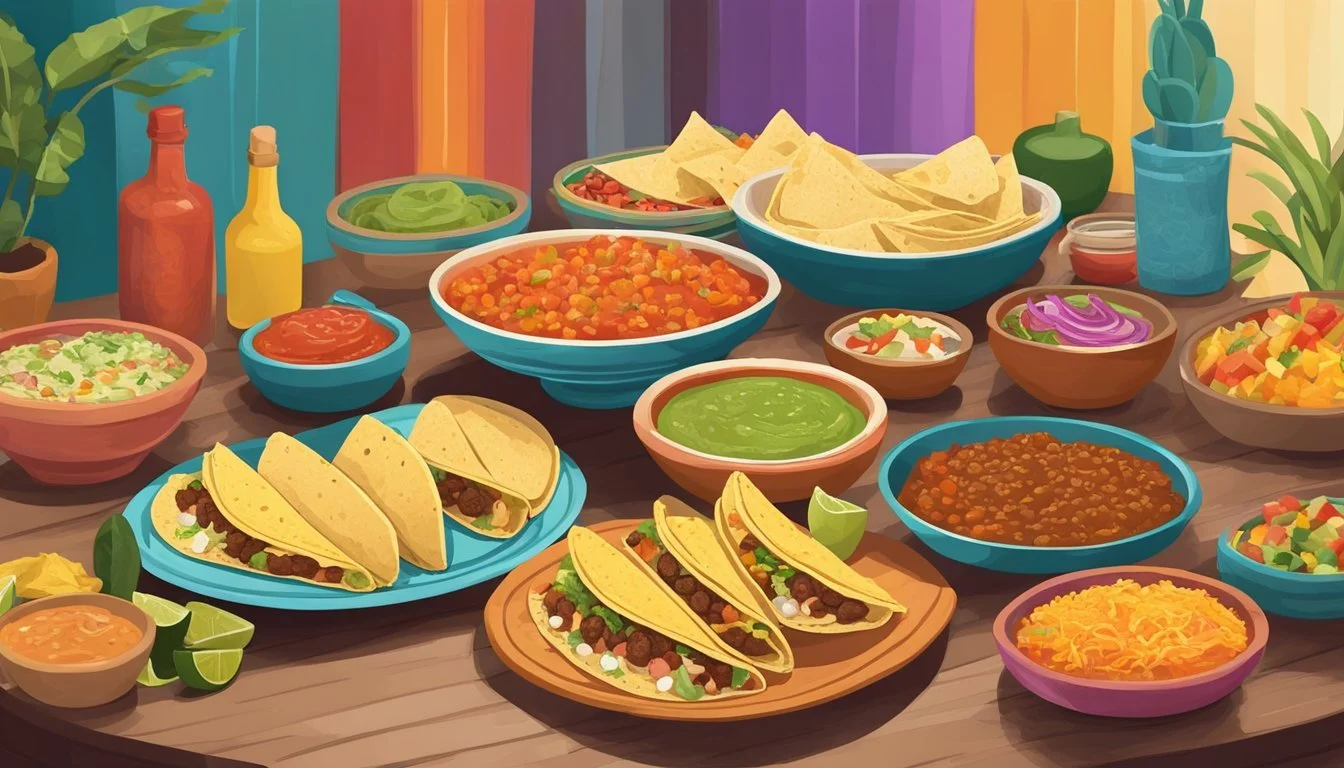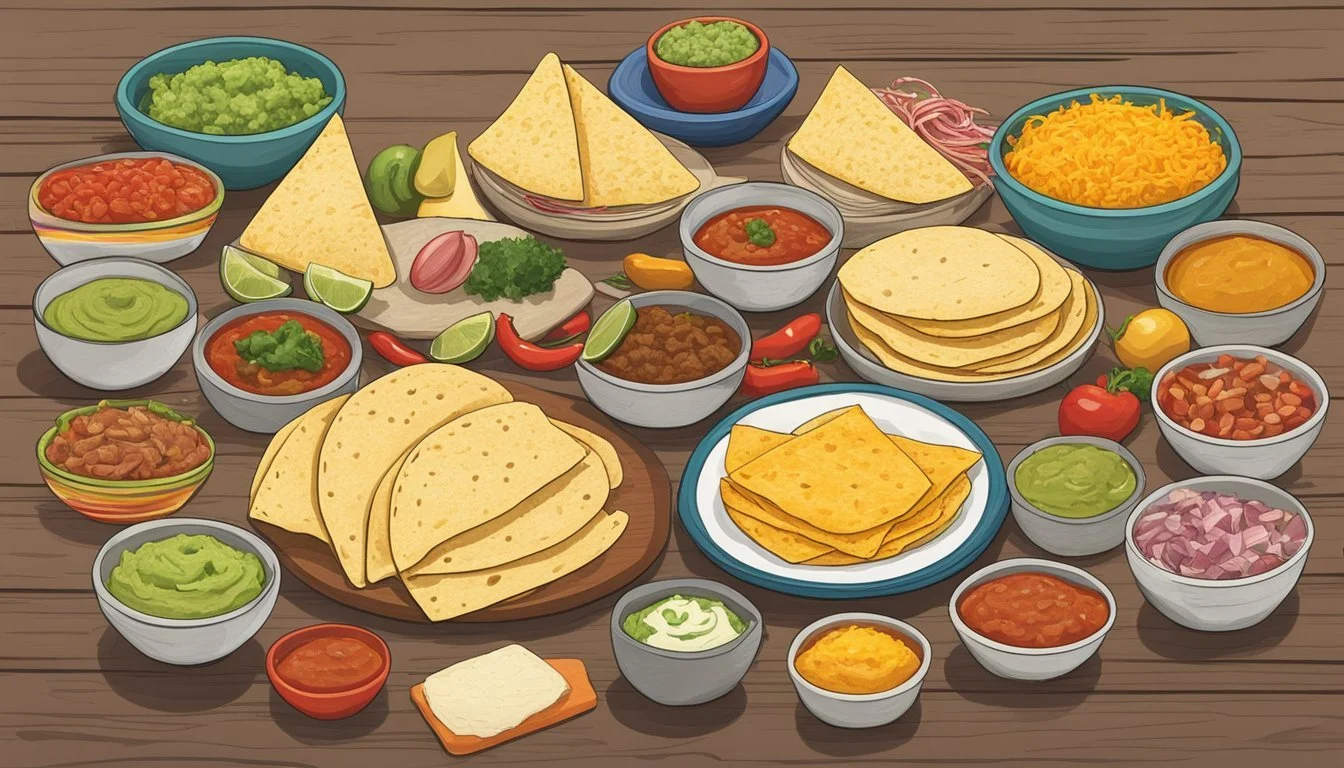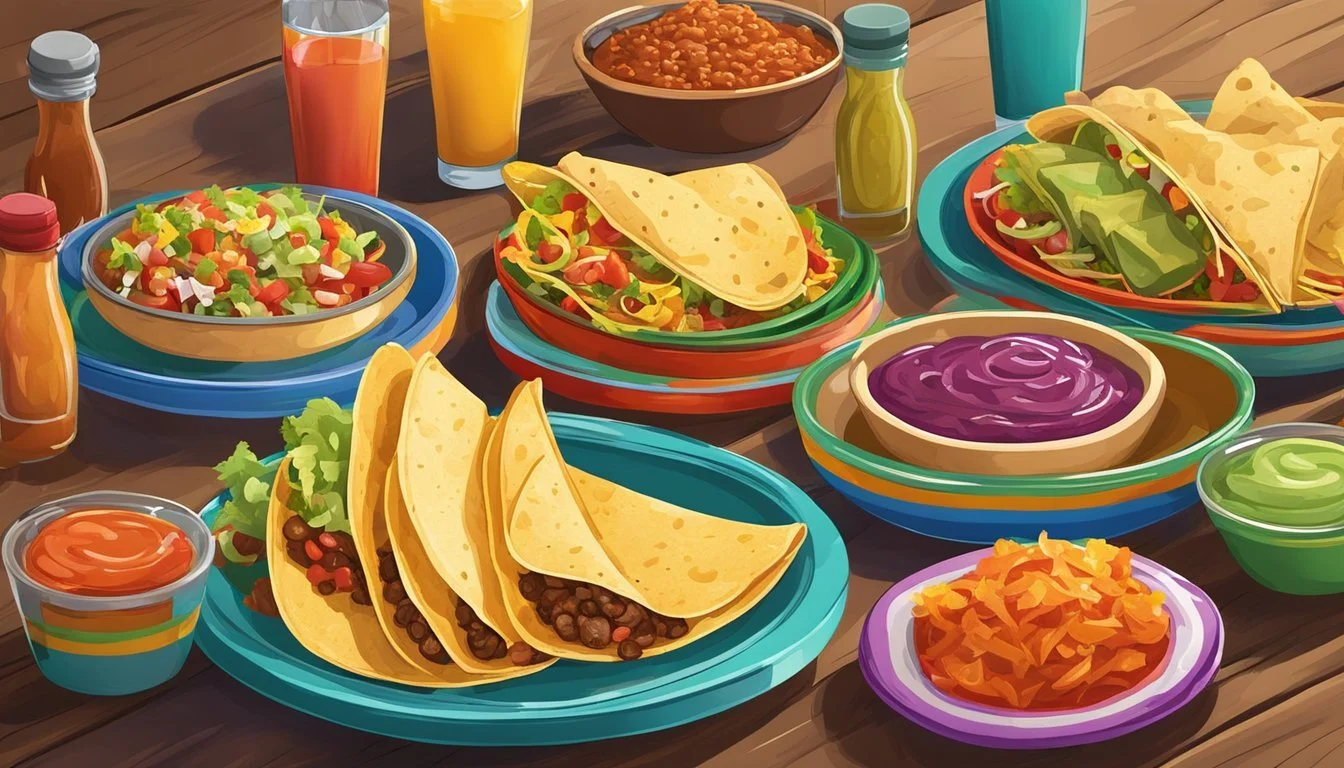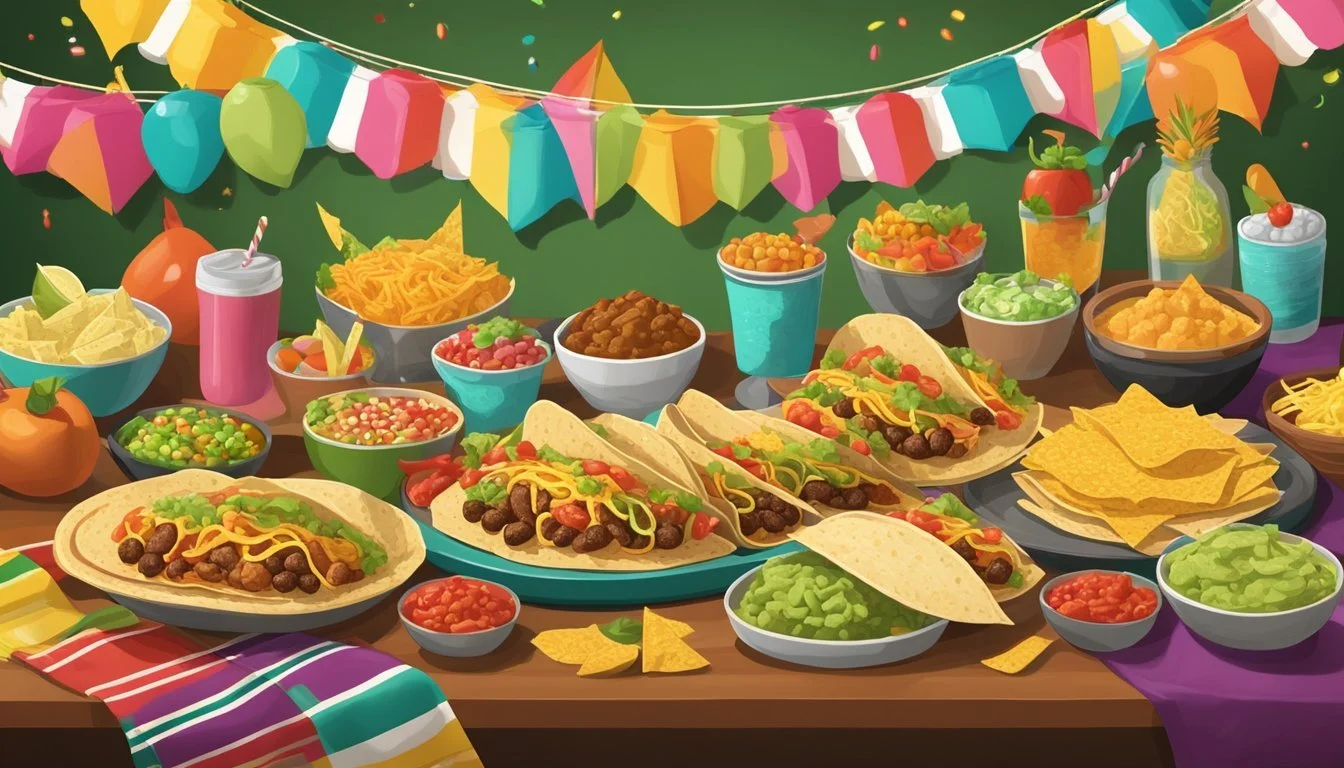How to Create a Tex-Mex Taco Bar for Parties
Your Ultimate Guide
Creating a taco bar for a party is an engaging and interactive way to serve food that can be customized to suit any taste. It's an excellent choice for gatherings of any size, allowing guests to tailor their plate to their own preferences. A Tex-Mex taco bar combines the vibrant flavors of Texas and Mexican cuisine, offering a variety of meats, beans, cheeses, and fresh toppings. This kind of setup not only simplifies the serving process but also adds an element of casual fun to the event.
To ensure a successful taco bar party, careful preparation is key. One should determine the amount of food needed based on the number of guests. A good rule of thumb is to plan for about 4-5 pounds of taco meat, which can be expected to make around 20 large tacos or even more if they're smaller. Accompanying that, one might want a selection of two cups of each topping to allow everyone to create their dream taco. Selection of toppings can include chopped lettuce, diced tomatoes, shredded cheese, salsa, and guacamole, among others.
Equally important as the food is the presentation of the taco bar. Arranging the components for smooth flow prevents bottlenecks and keeps the serving area tidy. Using tools like foil trays filled with ice can keep toppings cool, while serving utensils like tongs and spoons are essential for guest convenience. Layout should be thoughtful, placing items in an order that makes sense for building a taco, starting with shells and tortillas, followed by meats and beans, and ending with toppings and condiments.
Planning Your Taco Bar
When hosting a Tex-Mex taco bar, thoughtful planning ensures that every guest enjoys the festivities. Adequate preparation addresses different dietary preferences and optimizes the layout to serve a large crowd efficiently.
Assessing Guest Count and Dietary Needs
The key to a successful taco bar is knowing how many guests will attend and their dietary restrictions. This ensures ample food without overwhelming waste. For large gatherings, expect to prepare 4-5 pounds of taco meat to make about 20 sizable tacos. Vegetarian options, such as refried beans and rice, should also be included. They should plan for at least 2 cups of each topping to accommodate the needs of a large crowd or varying dietary requirements.
Guest Count: Estimate one ounce of cheese per guest.
Dietary Needs: Offer a mix of meat and vegetarian proteins, dairy and non-dairy cheese, and gluten-free tortillas.
Budgeting for Ingredients and Decorations
Creating a budget-friendly taco bar doesn't have to sacrifice quality. Guests can be impressed with a mix of homemade items and store-bought favorites. Investing in decorations such as table runners, centerpieces, or themed napkins adds a festive touch while being mindful of the budget. Buying in bulk and choosing seasonal toppings can also help in reducing costs.
Ingredients: Prioritize purchasing ingredients like tortillas and meats in bulk.
Decorations: Opt for cost-effective decorative elements that can be reused.
Setting Up the Taco Bar Layout
Tables should be set up in a manner that allows for easy flow and accessibility. Start the line with plates and silverware, followed by tortillas and shells. Then lay out the proteins, toppings, and condiments in an organized sequence. Position side dishes and vegetarian options distinctly to avoid any cross-contact for those with dietary restrictions. Place condiments and sauces toward the end to prevent bottlenecks. Designate a separate area for drinks and desserts to keep the main line moving smoothly.
Flow: Ensure the taco bar allows for easy movement and access.
Accessibility: Intuitively arrange dishes from the base (tortillas) to proteins, toppings, and condiments.
Shopping List Creation
Creating a comprehensive shopping list is the foundation of a successful Tex-Mex taco bar. It ensures that hosts have all the necessary ingredients to cater to varied tastes and dietary preferences.
Essential Taco Ingredients
For the base of the tacos, one's shopping list should include a variety of tortillas. It is advisable to have both soft flour tortillas and crunchy corn tortillas to accommodate different preferences.
Flour tortillas: At least two per guest
Corn tortillas: At least two per guest
A selection of taco meats is also essential. Traditional options like seasoned ground beef or shredded chicken are popular, but one might also consider offering a vegetarian option like black beans.
Taco meat (beef, chicken, etc.): 1/2 pound per guest
Black beans: One can per five guests
Toppings and Varieties
Toppings add color and flavor to tacos, so a variety is key. Basic toppings should include shredded cheese, lettuce, diced tomatoes, sour cream, guacamole, and salsa.
Shredded cheese: 1/4 cup per taco
Lettuce: 1 head per 10 guests
Tomatoes: 2 per 10 guests
Sour cream: 1/3 cup per guest
Guacamole: 1/4 cup per guest
Salsa: 1/3 cup per guest
One may also consider additional toppings like sliced jalapeños, diced onions, or cilantro for guests who enjoy extra layers of flavor.
Beverages and Dessert Options
Beverages should complement the spicy Tex-Mex flavors. Margaritas and beer are classic choices that tend to be well-received at such gatherings.
Margaritas: Two drinks per guest
Beer: At least one bottle per guest
For dessert, a simple and light option that offsets the hearty main course is advisable. Think along the lines of churros, flan, or cinnamon sugar tortilla crisps.
Desserts (churros, flan, etc.): One serving per guest
Lastly, do not forget the essentials like ice, lime slices for garnish, and any mixers for the margaritas. Remember to account for all possible guest preferences to ensure a well-rounded Tex-Mex taco bar experience.
Preparing the Proteins and Fillings
When setting up a Tex-Mex taco bar, the proteins and fillings are central for creating flavorful and satisfying tacos. Selecting a variety of meats and plant-based options, along with proper seasoning, caters to all tastes and dietary preferences.
Cooking and Seasoning Meats
For chicken, one can opt for shredded chicken. It should be cooked until tender, then hand-shredded and seasoned with a blend of chili powder, cumin, garlic powder, and oregano to infuse it with classic Tex-Mex flavors.
Ground beef is a staple for Tex-Mex tacos. It should be browned in a skillet and drained of excess fat. Meat should be thoroughly mixed with taco seasoning, which includes ingredients like chili powder, cumin, paprika, and a touch of cayenne for heat. Flour may be added to help thicken the mixture and bind the flavors.
Steak should be well-marinated and grilled to preferred doneness before being sliced into bite-size strips. The marinade might consist of lime juice, cilantro, minced garlic and a robust Tex-Mex spice mix.
Additionally, carnitas and barbacoa can be slow-cooked until they're fall-apart tender, ensuring that the rich flavors of the respective marinades have permeated the meat fully, typically involving spices similar to those used in taco seasoning and other aromatic ingredients like onion, garlic, and citrus juices.
Vegetarian and Vegan Alternatives
For those preferring vegetarian and vegan options, the taco bar can feature a range of proteins like tofu, tempeh, or textured vegetable protein (TVP). These alternatives can be seasoned with the same taco spices used for meats to emulate the familiar Tex-Mex flavors.
Legumes such as black beans or pinto beans may also serve as filling proteins. They should be well-cooked, seasoned, and possibly mashed for a refried beans consistency if desired. This provides an authentic Tex-Mex taste while accommodating non-meat eaters.
Remember, the key to a standout taco bar is in the seasoning and variety, ensuring a delectable experience for every guest regardless of their dietary preferences.
Setting Up and Serving
When setting up a Tex-Mex taco bar for parties, one should prioritize three critical aspects: the arrangement of ingredients and toppings, temperature control of the food, and managing the flow of guests for an enjoyable dining experience.
Arranging Ingredients and Toppings
For a seamless serving process, it's best to arrange all taco ingredients and toppings in an order that mimics how one would typically construct a taco. Place the foundational elements first, such as tortillas and taco meat. One can use Serving Dishes like ramekins and Individual Bowls for condiments and toppings. Ensure to provide Tongs for items like lettuce and cheese to prevent cross-contamination and maintain hygiene. A Tortilla Warmer should be used to keep tortillas at the perfect temperature for serving.
Suggested Serving Order:
Tortillas
Meats
Beans and Rice
Cheeses
Vegetables
Sauces and Salsas
Others (like sour cream)
Maintaining Food Temperature
To keep hot foods enjoyable and safe, one can use chafing dishes with Sterno flames. For chilled toppings such as sour cream and guacamole, an Inflatable Cooler filled with ice can help maintain a cool temperature. A two-tier setup with ice on the bottom and toppings on the tray above also works well to ensure freshness throughout the party without taking up too much space.
Facilitating Easy Flow for Guests
To prevent bottlenecks, set the taco bar on a long table accessible from both sides. This arrangement allows guests to serve themselves from either side and keeps the line moving smoothly. Clearly label each section with the ingredient name to quicken selection. Position the plates at the start and napkins with silverware at the end so guests can grab them after their hands are full. For larger parties, multiple stations with duplicates of popular items can reduce waiting time.
Taco Bar Enhancement Tips
Creating a taco bar for parties can become a memorable dining experience with the right enhancements. Presentation, diverse side dishes, and immersion through decor and music play pivotal roles in elevating a taco bar from good to great.
Creative Presentation Ideas
Bright Napkins and Fresh Flowers: Pairing vividly colored napkins with your taco bar adds a pop of color and enhances the festive atmosphere. Integrating fresh flowers as centerpieces or accents provides a touch of elegance.
Display Techniques:
Use tiered stands for salsas and toppings to create a dynamic visual height.
Presenting condiments in colorful ramekins can make the variety more approachable and easy to navigate.
Additional Side Dishes
Classic Tex-Mex Sides:
Mexican Rice: A zesty and colorful side that complements any taco filling.
Rice and Beans: Supplying both Mexican rice and a hearty bean dish gives guests filling options that are flavorful and satisfying.
Chips and Dips:
Offer a selection of Tortilla Chips with a range of dips, such as spicy Bean Dip or a cool, creamy guacamole, to cater to different taste preferences.
Themed Decor and Music Selections
Decor:
Incorporating elements like miniature cacti or sombreros can amplify the Tex-Mex vibe of the party.
For table settings, mix and match bold tableware with Bright Napkins to maintain a vibrant and inviting table display.
Music:
Carefully selected Mexican guitar music or lively mariachi bands streaming in the background can create an authentic ambiance.
Party Favors:
Consider giving guests themed party favors such as mini hot sauce bottles or maracas to extend the taco bar experience even after the event.
Health and Safety Considerations
When setting up a Tex-Mex taco bar for parties, it's important to prioritize the health and safety of guests to ensure a successful event. Key considerations include managing allergens/cross-contamination and maintaining strict hygiene during food preparation.
Managing Allergens and Cross-Contamination
For guests with food allergies, cross-contamination can be a real danger. It's essential to:
Separate utensils and serving dishes for different ingredients, especially if they contain common allergens such as dairy, nuts, or gluten.
Label all foods clearly with ingredients listed, so guests can avoid allergens.
Hygiene and Food Preparation
Proper hygiene is crucial to prevent foodborne illnesses. Key practices in food preparation should include:
Regular hand washing by anyone handling food, using warm water and soap for at least 20 seconds.
Keeping hot foods hot (above 140°F) and cold foods cold (below 40°F) to inhibit bacterial growth. Use chafing dishes or ice trays as needed.
Avoiding raw meat contamination by using separate cutting boards and knives for cooked and raw meats.
By adhering to these health and safety practices, hosts can minimize risks and ensure that all attendees have a safe and enjoyable dining experience.
Event Conclusion and Cleanup
After the celebration winds down, an efficient cleanup ensures a smooth transition back to order. The successful disassembly of a Tex-Mex taco bar and proper handling of leftovers and waste reflect careful planning and consideration for food safety and environmental responsibility.
Efficient Disassembly of the Taco Bar
At the end of a Birthday Party, Graduation Party, or any other festive gathering, disassembling the taco bar promptly allows for a clean and organized space. Begin by removing any hot dishes from warming trays or chafing dishes to prevent further cooking and potential food spoilage. Collect and stack the serving utensils, ramekins, and any unused disposable plates and napkins. Clear off any decoration or thematically relevant items, and wipe down the serving area to tackle any spills or residue.
Food Storage and Waste Management
For food storage, transfer remaining taco fillings into airtight containers and refrigerate promptly. It is critical to separate each topping to preserve freshness and prevent cross-contamination. Here is a brief guideline for leftover storage:
Meat: Place in a tightly sealed container and refrigerate for up to 3 days.
Sides: Rice and beans should cool to room temperature before storing; consume within two days.
Toppings: Fresh toppings like diced tomatoes or lettuce should be consumed as soon as possible for optimal freshness.
When it comes to waste management, compost any biodegradable waste where possible, and tightly bag any other trash to avoid attracting pests. Recycle disposable foil trays and plastic containers in accordance with local recycling guidelines. If disposables were used, consider environmental impact—opt for biodegradable or recyclable alternatives for future events.







